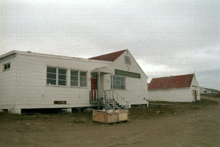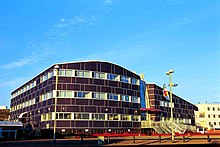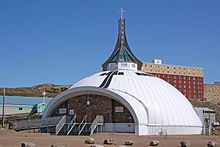Iqaluit
| Iqaluit ᐃᖃᓗᐃᑦ |
||
|---|---|---|
 Iqaluit port area |
||
| Location in Nunavut | ||
|
|
||
| State : |
|
|
| Territory : | Nunavut | |
| Region: | Qikiqtaaluk | |
| Local community: | Iqaluit | |
| Coordinates : | 63 ° 45 ′ N , 68 ° 33 ′ W | |
| Area : | 50.5 km² | |
| Residents : | 7740 (as of 2016) | |
| Population density : | 153.3 inhabitants / km² | |
| Time zone : | Eastern (UTC-5 / -4) | |
| Municipality number: | 867 | |
| Postal code : | X0A 0H0 X0A 1H0 |
|
| Area code : | +1 222, 975, 979 | |
| Foundation : | 1974 | |
| Mayor : | John Graham | |
| Website : | www.city.iqaluit.nu.ca | |
Iqaluit is the capital of the Canadian territory of Nunavut , which has existed since April 1, 1999, and is also the administrative seat of the Qikiqtaaluk region (Baffin). The city was raised to the rank of ville or city in 2001 . The Inuktitut word Iqaluit means “place with a lot of fish”.
history
Iqaluit, called Frobisher Bay until January 1, 1987, is located at the inner, northwestern end of Frobisher Bay on the southern Baffin Island in the Arctic Ocean . The place developed from a US air force base , which was established with the consent of the Canadian government in 1942 and in 1963 became the property of the Royal Canadian Air Force .
The ancestors of today's Inuit had resided in the region for around 4000 years, first people of the Dorset culture , then the Thule culture . Martin Frobisher was the first European to reach the bay that was later named after him in 1576 while searching for the Northwest Passage (without, however, penetrating to its end). In the 18th and 19th centuries, explorers, traders and whalers came to the coasts of the southern part of Baffin Island and finally missionaries.
In 1950, the Hudson's Bay Company relocated its trading post, which was 50 kilometers away at Ward Inlet, to a location on Frobisher Bay, which the Canadian government expanded in the mid-1950s into a model settlement called Apex (called Niaqunngut by the Inuit). Today Apex, 5 kilometers from the center of Iqaluit, is a suburb of the capital. The DEW Line (“Distant Early Warning Line”) began to be built in 1955 , and the number of inhabitants has increased fivefold since then. Iqaluit received its town charter in 1980.
When the capital for Nunavut was sought in 1995, Iqaluit was chosen in first place ahead of Rankin Inlet .
In 2002 the city hosted the Arctic Winter Games .
Demographics
The 2016 census showed a population of 7740 inhabitants and a median age of 31.1 years for the municipality . The median age of the territory in 2016 was 25.1 years. The local mean age was also 31.1 years, or 27.7 years in the territory.
At the 2011 census, the community had 6,699 inhabitants, almost 85% of whom were Inuit .
Facilities
At the seat of government in Iqaluit there are government buildings and a parliament building , the courthouse of Nunavut (but trials also take place in other locations), a police headquarters built in 2008 and a prison . Iqaluit also owns several churches , such as the Roman Catholic Church “Our Lady of the Assumption”, the Anglican Church “St. Simon "in Apex, a church of the Pentecostal (Pentecostal Church) and a Bahai -House.
The Anglican Church “St. Jude ”, modeled after an igloo, which was considered to be the most beautiful sacred building in the Arctic, was largely destroyed in an arson attack in 2004, after which it was torn down. The reconstruction with a slightly different architecture, but again in the form of an igloo, was completed in 2012. Funding it was difficult for the city of fewer than 6,000 inhabitants at the time of the arson attack. Canada's economic growth, fueled by rising raw material prices in the new millennium, as well as the stable population growth of the city itself ultimately favored reconstruction.
The "Nunatta Sunakkutanngit Museum" (historical and archaeological collection) and the "Unikkaarvik" visitor center (including a collection of fine Inuit art ) are also worth seeing . Iqaluit also has a clinic and other facilities.
Economy and Infrastructure
Education and Research
There are seven schools in the city that cover all primary and secondary education . Six of them are public schools and one private institution. In addition to schools teaching in English, there is a school in the city that teaches exclusively in French.
There are two colleges in the city, Nunavut Arctic College (Nunatta Campus) and Akitsiraq Law School .
media
The Nunatsiaq News is the city's largest newspaper ; it appears weekly. The second largest newspaper is called News / North . The city is also home to several radio stations: CBC Radio One provides verbal and current and local news, The New Triple 9 plays current chart music, and CFRT-FM is a local French-speaking station.
traffic
From Airport Iqaluit from several national destinations are available, for example, to Ottawa. It is also served by Airbus for the cold tests of newly developed aircraft. In the past, for example, the A380 and A350 landed here in the flight test phase.
Attractions
Iqaluit is the starting point for tours to the Qaummaarviit Historical Park , the Sylvia Grinnell Territorial Park and the Katannilik Territorial Park, which extends into the vicinity of the somewhat smaller town of Kimmirut . Due to the diverse flora and fauna, the Soper Heritage River Park is worth seeing.
Personalities
- Eva Aariak (* 1955), Canadian politician
- Paul Okalik (* 1964), former Prime Minister of Nunavut between 1999 and 2008
- Sheila Watt-Cloutier (* 1953), Canadian activist
climate
According to the Köppen and Geiger climate classification , the climate is classified as Sub-Arctic (Dfc).
| Iqaluit | ||||||||||||||||||||||||||||||||||||||||||||||||
|---|---|---|---|---|---|---|---|---|---|---|---|---|---|---|---|---|---|---|---|---|---|---|---|---|---|---|---|---|---|---|---|---|---|---|---|---|---|---|---|---|---|---|---|---|---|---|---|---|
| Climate diagram | ||||||||||||||||||||||||||||||||||||||||||||||||
| ||||||||||||||||||||||||||||||||||||||||||||||||
|
Average monthly temperatures and rainfall for Iqaluit
|
||||||||||||||||||||||||||||||||||||||||||||||||||||||||||||||||||||||||||||||||||||||||||||||||||||||||||||||||||||||||||||||||||||||||||||||||||||||||||||||||||||||||||||||||||||

literature
- Miriam Dewar (Ed.): The Nunavut Handbook: Traveling in Canada's Arctic . Ayaya Marketing & Communications, Iqaluit / Ottawa 2004, ISBN 0-9736754-0-3 (English).
Web links
Individual evidence
- ↑ About Iqualuit: History. In: City of Iqaluit. City of Iqaluit, accessed September 25, 2017 .
- ↑ https://www.iqaluit.ca/visitors/explore-iqaluit/history
- ^ Database and Search Engine for Direct Democracy. December 11, 1995: capital of Nunavut. Retrieved August 7, 2020 .
- ^ Iqaluit Community Profile. Census 2016. In: Statistics Canada . January 23, 2017, accessed March 13, 2019 .
- ↑ About Iqualuit: Demographics. In: Statistics Canada Census 2011. Statistics Canada, accessed December 30, 2012 .




